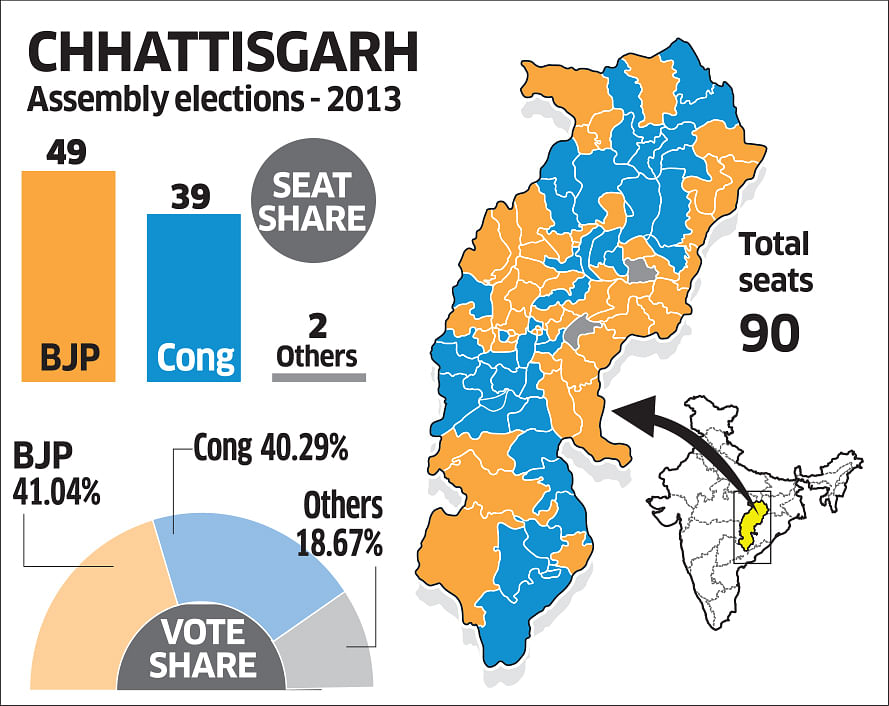Middle-aged Adivasi leader Sanau Ram Netam wears a pant and shirt like any urban person these days and also drives around in a car, but he makes it a point to tie a white turban in traditional Adivasi style on his head. He is from Narharpur block of North Bastar district, where he is an activist leader of Sarv Adivasi Samaj (SAS), the biggest non-political Adivasi group in Chhattisgarh, who can bring out a rally of 50,000 Adivasis in the capital, Raipur, anytime.
He is just back from Nagri Sihawa in the neighbouring Dhamtari district, where he was campaigning with SAS president and former IAS officer BPS Netam for tribal youth leader Vinod Nagvanshi. Nagvanshi is fighting on a tribal party – the Gondwana Gantantra Party -- ticket.
“Vinod will defeat Congress in Nagri Sihawa,” a distressed Sanau Ram told me sitting in the capital, Raipur. “BJP will win again. There is a lot of support for Vinod in the tribal community and people are surprised at the amount of money he is pouring into his campaign, obviously BJP has funded him.”
I remember meeting Nagvanshi, now a dynamic tribal youth leader, a few times when he was a private assistant to Nand Kumar Sai of the BJP, who is now head of the Central Scheduled Tribe Commission in Delhi. Sai is a former member of parliament who wants to be the tribal chief minister of Chhattisgarh and has for long been disappointed that the BJP does not project him as a leader. Vinod used to manage his appointments.
Congress president Rahul Gandhi shared platforms with Heera Singh Markam, the chief of the Gondwana Gantantra Party in rallies before elections were announced. The GGP did not win a single seat in the last elections but is the biggest political party of Adivasis in the state, where they constitute 31% of the population. They can get a few thousand votes in almost every constituency.
“All the smaller parties, like the Gondwana Gantantra Party, CPI, BSP put together had asked for around a dozen seats from Congress for a pre-poll coalition, but Congress has not learnt its lessons from Karnataka. It is still an arrogant party,” Sanau Ram said. “Maybe even AAP would have come along into the coalition, I don’t know. All these smaller parties will get less than 10,000 votes in each constituency, but that could be the victory margin. There are very few seats where the victory margin is going to be huge,” he said, explaining why the Congress would have done better to form the coalition.
In the 2013 elections, the difference in vote share between BJP and Congress was as low as 0.7%. This time around, all Congress leaders are talking about a wave in favour of change, which will sail them through. The BJP has been in power in Chhattisgarh for the last 15 years and fighting the election for a fourth term under the leadership of Chief Minister Raman Singh.
Says Congress leader Radhika Khera, “You can see that Narendra Modi is not there on the BJP hoardings here. They are fighting the election only in the name of Raman Singh. It is quite clear that Mr Modi does not want to take the blame for defeat.”
However, Congress is yet to put up a united face here. The party has not projected any leader as its chief ministerial candidate. While almost the party’s entire leadership was wiped out in a dastardly Maoist attack at Jhiram Valley in Bastar in May 2013, the party has at least three names making the rounds for who would be chief minister if the party wins. They are state party president Bhupesh Baghel, its legislative party leader and former royal of Surguja T S Singhdeo, and a recent entrant to the race, Tamradhwaj Sahu, who was projected at the last minute as Sahus are the biggest non-tribal caste who can change the equation in the central part of the state.
Eighteen seats in South Chhattisgarh, which is the hot bed of Maoist activity, went to polls on November 12, where it seems that Congress may have an edge due to anti-incumbency. Congress already holds 12 of the 18 seats. BJP leaders claim that Congress won so many last time due to a sympathy vote after the Jhiram attack on its leaders and that the results will be quite different this time. The polling percentage was almost the same, at 76.3%, as in 2013, which does not show that people came out in large numbers to vote for change.
“Unlike in Jharkhand, the BJP has given a stable government in Chhattisgarh. But it is ‘graveyard’ stability,” says former home secretary of the state, B K S Ray. “Corruption is high, the administrators have become law unto themselves, they are fearless. People here are silent but angry, and that will show in the results. Congress has a definite edge this time.”
Ravi Bhoi, a senior journalist, partly agrees, “Congress has an edge, but it is still very tough. The BJP has lots of money and 72 seats are yet to go to polls. Things can change in the last few days. The BJP has a big cadre base and a very strong poll machinery. Let’s see if Congress can overcome all that. Ajit Jogi could win half a dozen seats, and that can be decisive.”
But Sanau Ram Netam is not convinced that Congress has its game right. “Community forest rights is one of the main issue for our tribal community, but
Rahul Gandhi is not even talking about it.
Maybe his advisers don’t brief him properly. There is a lot of injustice around and we tribals feel that it may be a little better
with Congress. But all these smaller parties will ensure Congress’ defeat. I wish the Congress party was a little less arrogant.”
(The writer is co-founder of CGNet Swara, a community radio service on mobile phone, based in Raipur)
